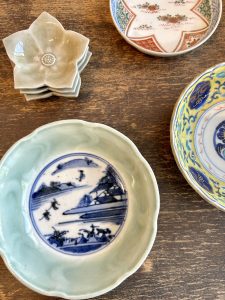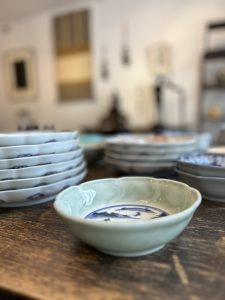青磁と染付の融合(愛知県名古屋市千種区姫池通 骨董買取 古美術風光舎)
2023.09.17
皆さまこんにちは。スタッフHでございます。
今年の夏は、店に飾られていた南部鉄器の風鈴の音色に癒されました。風鈴の音は実際に体温を下げる効果があるそうです。しかしこれは日本人に特有の効果で、風鈴の音色から風を感じ取っているとか。文化の違いは脳の働きにまで影響するのですね。
さて私、こちらでお仕事をさせていただき、まだ日も浅く古美術の知識も乏しいのですが、お店に陳列されている名品を眺めながら好みのものを少しずつ勉強していきたいと思っております。基本の基ばかりですが、お付き合いいただければ幸いです。
まずはこの青磁と染付が淡い色合いで融合した伊万里焼の膾皿(なますざら)。こちらのお皿は明治期に作られたものですが、青磁と染付を融合した伊万里焼は江戸時代、1630年頃には生まれていました。

盛り付けた時には料理の邪魔をせず、食べ終えると墨絵のような染付が現れ楽しい気分になれそうです。
なます皿は5寸皿でおよそ直径15センチのサイズ。縁が立ち上がった形をしており、深さがあるので煮物や汁がある料理も盛り付けやすくなっています。実際家庭でも最も出番の多いサイズではないでしょうか。

名前のとおり、「なます」などの副菜を盛る器として江戸時代ころから庶民の間で用いられてきました。「なます」とはおせち料理などに入っている紅白なますなど、肉・魚・野菜などをお酢に浸して味付けしたもので、日本で最も古い調理法と言われているそうです。冷蔵庫などがなかった当時はお酢を使った料理は今よりもっと食卓に上っていたのかなと思います。
取り皿にもなるサイズで、現在でも使い方は無限ではないでしょうか。
もともと青磁は中国で発展した陶磁器で、1%から2%の酸化第二鉄を混ぜた釉薬を塗って焼くことで青い色が生まれます。さらに青磁には「還元炎焼成」が必要で、窯内の酸素を調整し、焼成物から酸素を奪うという工程が重要になります。「還元」と聞いただけで学生時代の化学式が脳裏をかすめ、拒絶反応を起こしそうになりますが…。
簡単にいうと窯の中の酸素を抜いて、釉薬や素地の中の鉄分が反応して青くなるとのこと。酸素を限りなく抜けば青くなり、ほどほどに抜けば緑になる。その青と緑の間のグラデーションが青磁の色味の楽しみということでしょうか。
酸素をある程度入れて焼くと、オレンジや黄色にもなり、これも青磁と呼ばれるそうです。
染付は素地の上に主成分が酸化コバルトの呉須と呼ばれる青色顔料で文様を描き、その上に透明の釉薬を施して焼成します。線描き、濃み(ダミ)、吹墨、墨弾きなどの高度な技術が必要とされ、描き手の技量により差が生まれやすいともいわれています。藍一色の濃淡で描かれる奥行のある景色は、吸い込まれるような、ずっと見ていたくなるような不思議な感覚になります。

化学の知識がまだ乏しい時代に、この二つの技法を融合させ、理想の作品を作り出そうとした陶工たち。かなりの忍耐と努力が必要だったと想像しますが、夢のある世界でもありますね。
それでは、またお会いしましょう。
Hello everyone. This is Staff H.
This summer, I was healed by the sound of Nambu ironware wind chimes displayed in our store. It is said that the sound of wind chimes actually has the effect of lowering body temperature. However, this is an effect unique to Japanese people, who sense the wind from the sound of wind chimes. So cultural differences even affect the way our brains work.
It has been only a short time since I started working here, and my knowledge of antiques is still limited, but I would like to learn little by little what I like among the masterpieces on display in the store. I will try to learn a little bit about some of the masterpieces on display in the shop that I like.
First of all, this Imariyaki namasu plate, which is a fusion of celadon and underglaze blue.
I thought the combination of colors was wonderful. When served, the dish does not interfere with the food, but when you finish eating, the ink painting-like underglaze blue appears and gives you a rich feeling.
The dish is a 5″ dish with a diameter of about 15 cm. It has a raised rim and is deep, making it easy to serve stewed or soupy dishes. In fact, it is probably the size most frequently used in the home.
As the name suggests, this dish has been used by the general public since around the Edo period (1603-1867) as a vessel for serving side dishes such as “namasu. Namasu” is said to be the oldest cooking method in Japan. It consists of meat, fish, vegetables, etc. soaked in vinegar and seasoned. It is said to be the oldest cooking method in Japan. I imagine that in those days when there were no refrigerators, dishes using vinegar appeared more often than now.
The size of this dish can also be used as a serving plate, and its usage is probably unlimited even today.
This plate was made in the Meiji period, but works that fused celadon and underglaze blue were created in the Edo period, around 1630. Celadon porcelain was originally developed in China, where the blue color is produced by applying a glaze mixed with 1% to 2% ferric oxide and firing. Furthermore, celadon requires “reduction flame firing,” a process in which the oxygen in the kiln is adjusted to deprive the fired product of oxygen. The mere mention of the word “reduction” may make you think of the chemical formulas from your school days, and you may reject the idea of reduction firing.
Simply put, the oxygen in the kiln is removed, and the iron in the glaze and the base material reacts to turn blue. If you remove as much oxygen as possible, it becomes blue, and if you remove it moderately, it becomes green. The gradation between blue and green is the color of celadon porcelain.
When fired with a certain amount of oxygen, it can become orange or yellow, which is also called celadon.
In the process of applying blue glaze, a pattern is drawn on the base with blue pigment called gosu, which is mainly composed of cobalt oxide, and then a transparent glaze is applied over the pattern and fired. It is said that the skill of the artist tends to vary, requiring advanced techniques such as line drawing, dammi, fuki sumi, and sumi bouncing. The depth of the scenery depicted in a single shade of indigo is so magical that it seems to absorb you and make you want to keep looking at it.
At a time when knowledge of chemistry was still scarce, potters attempted to fuse these two techniques to create ideal works of art. I imagine it took a lot of patience and effort, but it is also a world of dreams.
So, I will see you again.
*******************
ご実家の整理やお片付けなどをされている方のご相談などが多くございます。
お片付けなどくれぐれもご無理のないようになさってくださいませ。
風光舎では古美術品や骨董品の他にも絵画や宝石、趣味のお品など様々なジャンルのものを買受しております。
お片付けをされていて、こういうものでもいいのかしらと迷われているものでも、どうぞお気軽にご相談下さいませ。
また風光舎は、出張買取も強化しております。ご近所はもちろん、愛知県内、岐阜県、三重県その他の県へも出張いたします。
まずは、お電話お待ちしております。
愛知県名古屋市千種区姫池通
骨董 買取【古美術 風光舎 名古屋店】
TEL052(734)8444
10:00-17:00 OPEN
#出張買取#骨董#古美術#骨董品#絵画#版画#茶道具#刀剣#彫刻

